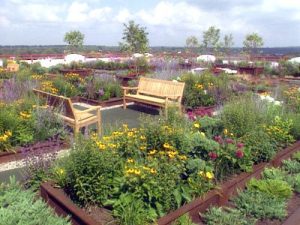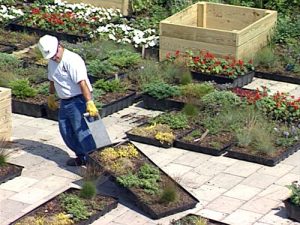Have you ever walked down a street, looked up and seen a tree on top of a 15-story office building? Your eyes are not deceiving you, that building has Vegetative (or Green) Roofing.
Vegetative or “Green” Roofing is when plants are installed over the weatherproofing layer on a commercial roof. This could be in conjunction with pathways and areas for people, or it could just be an environmental/sustainable push from a company.
 Depending on the structure of the building, you can install grass, bushes, flowers, trees or even fruits and vegetable plants! If the roof is accessible, pavers can be added as walkways and tables to expand the usable space for tenants.
Depending on the structure of the building, you can install grass, bushes, flowers, trees or even fruits and vegetable plants! If the roof is accessible, pavers can be added as walkways and tables to expand the usable space for tenants.
Why Choose Vegetative Roofing?
There are many reasons that building owner would choose to install vegetative roofing on their facility. Whether you are renting out space in your building or you own your building, installing a vegetative roof could bring in more money through higher prices or increased productivity.
- Expand Usable Space – By adding more places for people to hang out, eat lunch or hold meetings, you are capitalizing on a square footage that your building offers.
- Upgrade Facility Aesthetics – Having a well-maintained space upgrades the perceived value of your facility. A rooftop patio or garden can be an offering that tenants are willing to pay for.
- Employee Wellness/Satisfaction – The more dedicated relaxation areas you can provide to your employees, the higher employee morale will be.
- Environmentally Friendly and Sustainable – Not only can vegetative green roofs save energy costs associated with heating and cooling the facility, therefore reducing your building’s carbon footprint
Vegetative Roofing Installation
If a facility is able to have a vegetative roof installed, it means that the substrate is strong and probably made of concrete. If not, the substrate needs to be reinforced to handle the weight and traffic of the green roof.
A Green Roof installation starts with a waterproof membrane. This membrane can be one of a few choices:
- Rubberized Asphalt
- Modified Bitumen
- Spray Polyurethane
- Single-Ply Membrane
- Polyvinyl Chloride (PVC)
Read More: Pros and cons of the waterproofing choice at Whole Building Design Guide
After the substrate is reinforced and the waterproofing membrane is installed, there are two options for how your vegetation is installed.
Tray Systems
A tray system is a rather easy way to bring vegetation to your facility roof. The plants, or other vegetation, are planted in lightweight trays that are brought up to the roof. These tray systems can be interconnecting and specialized edges, along with growing plants, can conceal the trays to create a seamless look.
Advantages of tray systems:
- Maximum stormwater management with trays designed to capture waterfall
- Easy installation
- Plants can be grown before installation

Layered Systems
The second option to install vegetation on a facility roof is with a layered system; layered systems are installed directly onto the roof surface. There are two types of layered vegetative systems: Extensive Systems are more modular, and Intensive Systems are deeper.
When the vegetation is not limited to trays, more layers need to be installed to protect the facility from water damage:
- Water Retention Layer – Properly holds water for the plants and other vegetation, it’s important that the water is available for the plants but doesn’t sit on the facility structure where it can cause water damage.
- Drainage Layer – Helps the water drain properly and prevent water from sitting on the roof and causing damage.
Advantages of tray systems:
- Lighter option when including trays
- More choices with installation shape
Vegetative Roof Assembly: Interactive Diagram from Henry
Disadvantages of Vegetative Roofing
Commercial roof design to grow vegetation can be a lot of stress on the facility and added work to staff. Not all facilities are equipped to handle the disadvantages of vegetative roofing:
- Roof Maintenance – When you have a layer of vegetation, what happens when maintenance needs to be performed on the membrane underneath? Access to the substrate, insulation or waterproof membrane can be a big problem when you need to move heavy trays of vegetation or dig through layers of plants and soil.
- Unwanted Wildlife and Insects – If you have cared for a garden, you know that you get more than flowers, you get all of those that live on and with the vegetation. Although some may not see this a disadvantage.
- Added Weight – In addition to the traditional weight of a waterproof roof system, you can add 10 – 50 pounds per square foot when you add in the soil, retained water, vegetation, walking paths and even people.
- Upkeep – Every commercial roof should be maintained regularly, but not every roof needs to be watered. When you have living vegetation on your roof, you have year-round care depending on your climate. From watering to pulling weeds, there is more work to maintain a vegetative roof.
Vegetative roofing is not a common roof type for commercial, industrial and manufacturing facilities. If your facility is able to host vegetation, it is a great option for tenant/employee morale, while giving back to the environment.
Is your roof not suitable for green roofing? Read about the most common commercial roofing to start your project.


